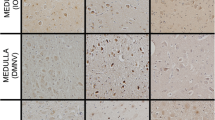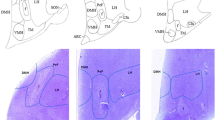Abstract
Beta-endorphin (BEND) may induce respiratory depression. Elevated levels of beta-endorphin immunoreactivity (BENDI) in the CSF are found in children with apnoea and in about 50% of sudden infant death (SID) victims. Premortal hypoxia in SID victims has been indicated by elevated hypoxanthine (HX) levels in the vitreous humour (VH). In this study we correlated BENDI in CSF with HX in VH in SID victims (n=19) and controls (n=18). BEND in CSF was measured by RIA, and HPLC was used for identification of BENDI. HX in VH was measured by HPLC. All the SID victims had elevated levels of HX in VH. The BENDI in CSF divided the SID victims into two subpopulations (P<0.01); one with undetectable levels (<4.3 fmol/ml) (n=10) and one with high levels (160–400 fmol/ml) (n=9).In the SID subpopulation with high levels of BENDI in CSF,we found a correlation between BENDI in CSF and HX in VH (r=0.92). Control infants who died a stressful death, such as during heart operations (n=2), had high levels of BENDI in CSF and low levels of HX in VH. Controls who died of infections (n=11) had low levels of BENDI in CSF and elevated levels of HX in VH. Because hypoxia in itself does not increase BENDI in CSF, increased BENDI in CSF is probably not secondary to hypoxia but may be of aetiological significance. We therefore suggest that SID victims with high levels of BENDI in CSF, which correlate with the elevated levels of HX in VH, may die from premortal hypoxia possibly induced by BEND.
Similar content being viewed by others
Abbreviations
- BEND:
-
beta-endorphin
- BENDI:
-
beta-endorphin immunoreactivity
- CSF:
-
cerebrospinal fluid
- HPLC:
-
high performance liquid chromatography
- HX:
-
hypoxanthine
- RIA:
-
radioimmunoassay
- SID:
-
sudden infant death
- VH:
-
vitreous humour
References
Akil H, Watson SJ, Young E, Lewis ME, Khachatturain H, Walker JM (1984) Endogenous opioids. Biology and function. Ann Rev Neurosci 7:223–255
Brady JP, Chir B, Gould JB (1984) Sudden infant death syndrome the physisican's dilemma. Year book medical publisher, Chicago
Burbach JPH, Loeber JG, Verhoff J, Kloet ER de, Van Ree JM, Wied D de (1979) Schizofrenia and degradation of endorphins in cerebrospinal fluid. Lancet II:480–481
Butterworth J, Tennant MC (1989) Postmortem human brain pH and lactate in sudden infant death syndrome. J Neurochem 53:1494–1499
Carey EM, Foster PC (1984) The activity of 2′,3′-cyclic nucleotide 3′-phosphohydrolase in corpus callosum, subcortical white matter,and spinal cord in infants dying from sudden infant death syndrome. J Neurochem 42(4):924–929
Farabollini F, Faccinetti F, Lupo C, Carli G (1990) Time course of opioid and pituriary-adrenal hormone modifications during the immobility reaction in rabbits. Physiol Behav 47: 337–341
Freedman A, Scardella AT, Edelman NH, Santiago TV (1988) Hypoxia does not increase CSF or plama beta-endorphin activity. J Appl Physiol 7:223–255
Gilbert-Barness E,Valdes-Dapena M, Steinschneider A, Chandra S (1992) Reproducibility of Naeye's seven tissue markers of hypoxia. Pediatric Pathology 12(3):481–482
Hassen AH, Feuerstein G, Faden AJ (1982) My receptors and opioid cardiovascular effects in the NTS of rat. Peptides 3: 1031–1037
Kelly DH, Pathak A, Meny R (1991) Sudden severe bradycardia in infancy. Pediatr Pulmonol 10:199–204
Kinney HC, Burger PC, Harell FE, Hudson RP (1983) Reactive gliosis in the medulla oblongata of victims of the sudden infant death syndrome. Pediatrics 72:181–187
Myer EC, Morris DL, Adams ML, Brase DA, Dewey WL (1987) Increased cerebrospinal fluid beta-endorphin immunoreactivity in infants with apnea and siblings of victims of sudden infant death syndrome. J Pediatr 111(5):660–666
Myer EC, Morris DL, Brase DA, Dewey WL, Zimmerman AW (1990) Naltrexone therapy of apnea in children with elevated cerebrospinal fluid beta-endorphin. Ann Neurol 27(1): 75–80
Naeye RL (1973) Pulmonary arterial abnormalities in the sudden infant death syndrome. N Engl J Med 289:1167–1170
Naeye RL (1980) Sudden infant death Sci Am:242–256
Naeye RL (1980) Brainstem and adrenal abnormalities in the sudden infant death syndrome. Am J Clin Pathol 66:526–530
Naeye RL, Fisher R, Rubin R, Demers LM (1980) Selected hormone levels in victims of the sudden infant death syndrome. Pediatrics 65:1134–1136
Nemeroff CB, Berger PA, Bissette G (1987) Peptides in schizophrenia. In: Meltzer HY (ed) Psychopharmalogy: the third generation of progress. Raven Press, New York pp 727–743
Parker JC (1981) The brainstem in sudden infant death syndrome. A postmortem survey. Am J Forensic Med Pathol 2(2): 121–127
Richards PT, Cuzner ML (1987) Proteolytic activity in CSF. Adv Exp Med Biol 100:521–527
Rognum TO, Saugstad OD (1993) Biochemical and immunologycal studies in SIDS victims. Clues to the understanding of the death mechanism. Acta Pediatr Scand [Suppl] 389:82–85
Rognum TO, Saugstad OD (1991) Hypoxanthine levels in vitreous humor: evidence of hypoxia in most infants who died of sudden infant death syndrome. Pediatrics 87:306–310
Rognum TO, Saugstad OD, Øyasæter S, Olaisen B (1988) Elevated levels of hypoxanthine in vitreous humor indicate prolonged cerebral hypoxia in victims of sudden infant death syndrome. Pediatrics 82:615–618
Shook JE, Watkins WD, Camporesi EM (1990)Differential roles of opioid receptors in respiration, repiratory disease, and opiate-induced respiratory depression. Am Rev Respir Dis 142: 895–909
Southall DP, Samuels MP, Talbert DG(1990) Recurrent cyanotic episodes with severe arterial hypoxaemia and intrapulmonary shunting: a mechanism for sudden death. Arch Dis Child 65:953–961
Storm H, Reichelt KL, Rognum TO (1990) Beta-endorphin, human caseomorphin and bovine caseomorphin immunoreactivity in CSF in sudden infant death syndrome and controls. Preceeding of the International Narcotics Research Conference (INRC) 1989. Alan R Liss Inc, New York, pp 327–330
Takashima S, Armstrong D, Becker LE (1978) Cerebral white matter lesions in sudden infant death syndrome. Pediatrics 62: 155–159
Takashima S, Armstrong D, Becker L, Bryan C (1978) Cerebral hypoperfusion in the sudden infant death syndrom? Brainstem gliosis and vasculature. Ann Neurol 4(3):257–262
Valdes-Dapena (1992) The sudden infant death syndrome: pathologic findings. Clin Perinatol 19(4):701–716
Author information
Authors and Affiliations
Rights and permissions
About this article
Cite this article
Storm, H., Rognum, T.O., Saugstad, O.D. et al. Elevated beta-endorphin immunoreactivity in the cerebrospinal fluid in victims of sudden infant death correlates with hypoxanthine in vitreous humour. Eur J Pediatr 152, 935–938 (1993). https://doi.org/10.1007/BF01957536
Received:
Accepted:
Issue Date:
DOI: https://doi.org/10.1007/BF01957536




